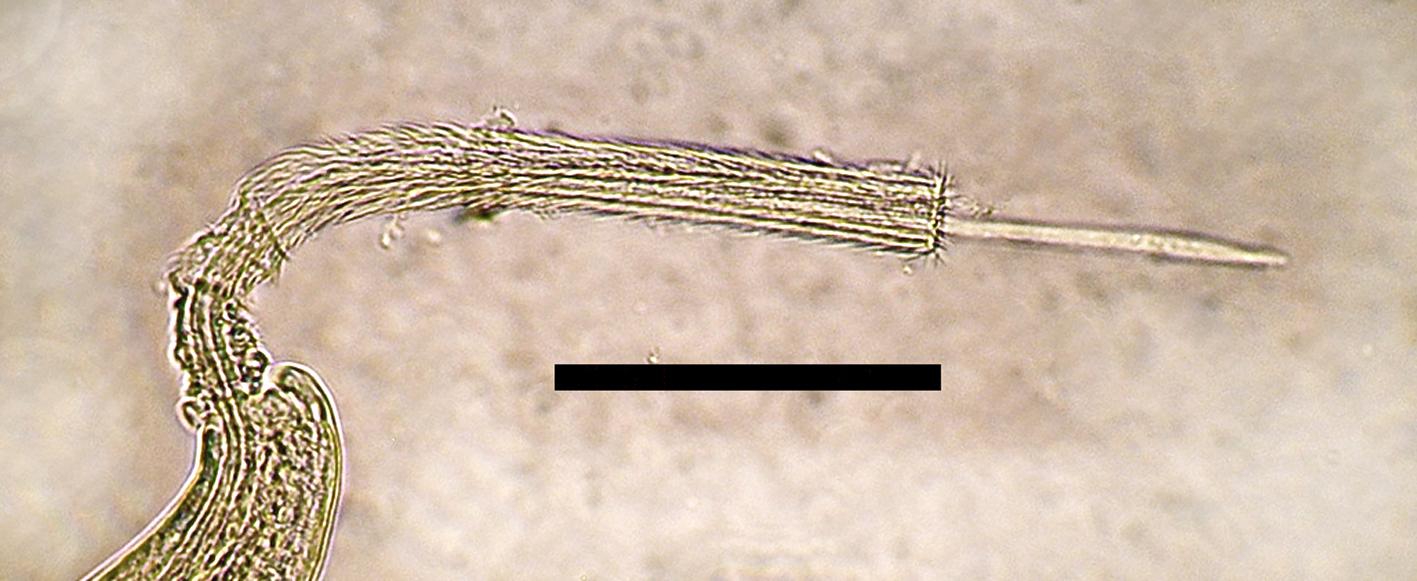Trichocephalida on:
[Wikipedia]
[Google]
[Amazon]
The Trichocephalida (Trichinellida or Trichurida in other classifications) is an order of parasitic nematodes.
Free PDF
(2 subfamilies, 5 genera, 25 species) including ''
 All members of this order are histiotrophic, meaning that in at least one stage of their
All members of this order are histiotrophic, meaning that in at least one stage of their
Taxonomy
The order Trichocephalida includes, according to modern classifications, the single suborder Trichinellina Hodda, 2007, which itself includes the single superfamily Trichinelloidea Ward, 1907, which itself includes 6 families: * FamilyAnatrichosomatidae
Anatrichosomatidae is a family of nematodes belonging to the order Trichocephalida.
Genera:
* ''Anatrichosoma
''Anatrichosoma'' is a genus of nematodes
The nematodes ( or grc-gre, Νηματώδη; la, Nematoda) or roundworms constitu ...
Yamaguti, 1961 (1 genus
Genus ( plural genera ) is a taxonomic rank used in the biological classification of living and fossil organisms as well as viruses. In the hierarchy of biological classification, genus comes above species and below family. In binomial nom ...
, 5 species) including the single genus '' Anatrichosoma''
* Family Capillariidae
''Capillariidae'' is a family of parasitic nematodes. All its members are parasites in vertebrates when they are in their adult stage.
Taxonomy
The family Capillariidae was created by Railliet in 1915. It is accepted in the most recent classifi ...
Railliet, 1915 Railliet, A. 1915: L'emploi des médicaments dans le traitement des maladies causées par des Nématodes. ''Recueil de Médecine Vétérinaire, Paris,'' 91, 490–513. ot seen/ref> (1 subfamily, 18-22 genera according to classifications,Moravec, F. 2001: Trichinelloid Nematodes parasitic in cold-blooded vertebrates. Academia, Praha, 432 pp. (list of genera of Capillariidae in pages 30-32) () 390 species) including '' Capillaria''
* Family Cystoopsidae
Cystoopsidae is a family of nematodes belonging to the order Trichocephalida
The Trichocephalida (Trichinellida or Trichurida in other classifications) is an order of parasitic nematodes.
Taxonomy
The order Trichocephalida includes, according ...
Skrjabin, 1923 (2 subfamilies, 2 genera, 7 species)
* Family Trichinellidae
The family Trichinellidae includes the genus ''Trichinella''.
''Trichinella'', also known as the trichina worm, is responsible for the disease trichinosis
Trichinosis, also known as trichinellosis, is a parasitic disease caused by roundwor ...
Ward, 1907 (4 genera, 16 species) including ''Trichina
''Trichinella'' is the genus of parasitic roundworms of the phylum Nematoda that cause trichinosis (also known as trichinellosis). Members of this genus are often called trichinella or trichina worms. A characteristic of Nematoda is the one-w ...
''
* Family Trichosomoididae
The ''Trichosomoididae'' is a family of nematodes.
Morphological characteristics
The Trichosomoididae, as most nematodes, have an elongate body, vermiform and covered with a cuticle. There is often a cuticular ornamentation in form of cephalic ...
Hall, 1916Hall, M.C. 1916: Nematode parasites of mammals of the orders Rodentia, Lagomorpha and Hyracoidea. Proceedings of the U.S. National Museum, 50, 1–24Free PDF
(2 subfamilies, 5 genera, 25 species) including ''
Huffmanela
''Huffmanela'' is a genus of parasitic nematodes, belonging to the family Trichosomoididae.
Morphology
As other nematodes, species of ''Huffmanela'' are elongate and vermiform. They are especially thin and small. The male is smaller than the fem ...
''
* Family Trichuridae Ransom, 1911 (1 subfamily, 6 genera, 107 species) including ''Trichuris
''Trichuris'', often referred to as whipworms (which typically refers to ''T. trichiura'' only in medicine, and to any other species in veterinary medicine), is a genus of parasitic worms from the roundworm family Trichuridae, which are helmin ...
''
Note that another slightly different arrangement of families exists, with the Family Trichosomoididae
The ''Trichosomoididae'' is a family of nematodes.
Morphological characteristics
The Trichosomoididae, as most nematodes, have an elongate body, vermiform and covered with a cuticle. There is often a cuticular ornamentation in form of cephalic ...
including '' Anatrichosoma'' in a subfamily Anatrichosomatinae.
Biology
 All members of this order are histiotrophic, meaning that in at least one stage of their
All members of this order are histiotrophic, meaning that in at least one stage of their life cycle
Life cycle, life-cycle, or lifecycle may refer to:
Science and academia
*Biological life cycle, the sequence of life stages that an organism undergoes from birth to reproduction ending with the production of the offspring
* Life-cycle hypothesis ...
, they develop in cell
Cell most often refers to:
* Cell (biology), the functional basic unit of life
Cell may also refer to:
Locations
* Monastic cell, a small room, hut, or cave in which a religious recluse lives, alternatively the small precursor of a monastery ...
s or tissues. They are all parasites in vertebrates
Vertebrates () comprise all animal taxa within the subphylum Vertebrata () (chordates with backbones), including all mammals, birds, reptiles, amphibians, and fish. Vertebrates represent the overwhelming majority of the phylum Chordata, with c ...
in their adult stage. The anterior end is narrower than the posterior end in most of these worms, and the esophagus
The esophagus ( American English) or oesophagus (British English; both ), non-technically known also as the food pipe or gullet, is an organ in vertebrates through which food passes, aided by peristaltic contractions, from the pharynx to ...
is slender and embedded in cells called stichocytes which form a stichosome. Eggs of members of this order have bipolar or biopercular plugs (except in a few species).
References
{{Taxonbar, from=Q4051744 Parasitic nematodes of vertebrates Nematode orders es:Trichurida sk:Nitkovky